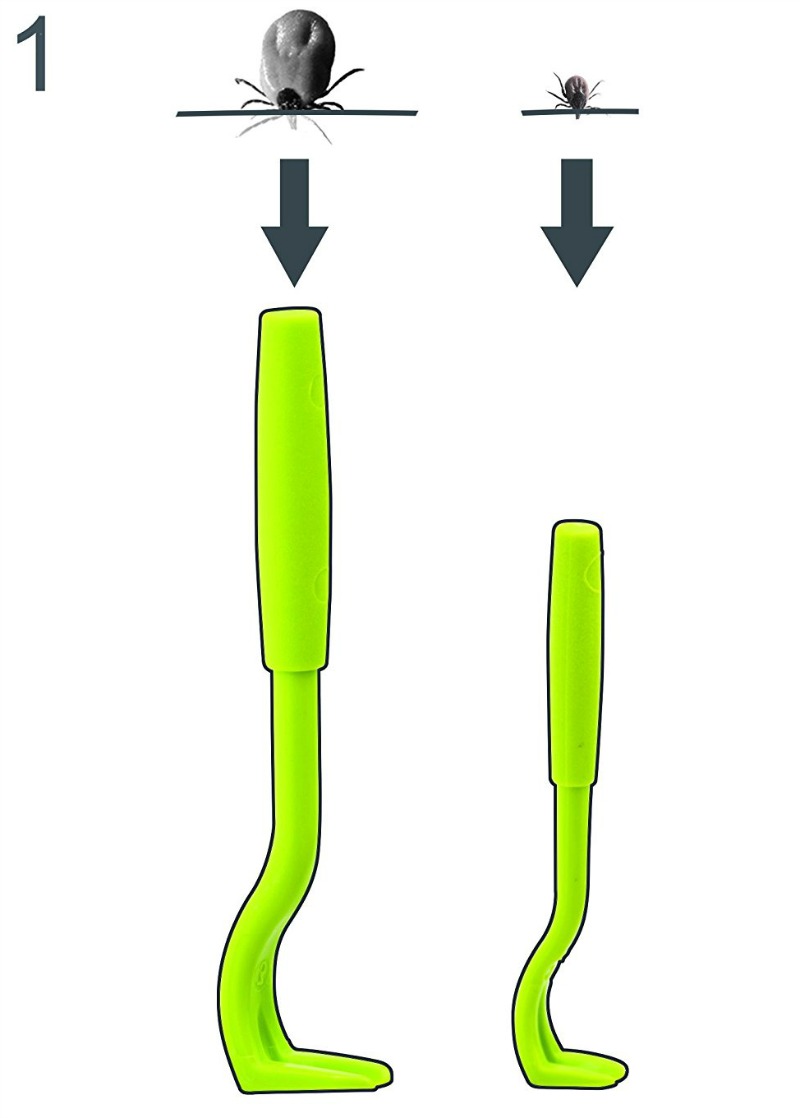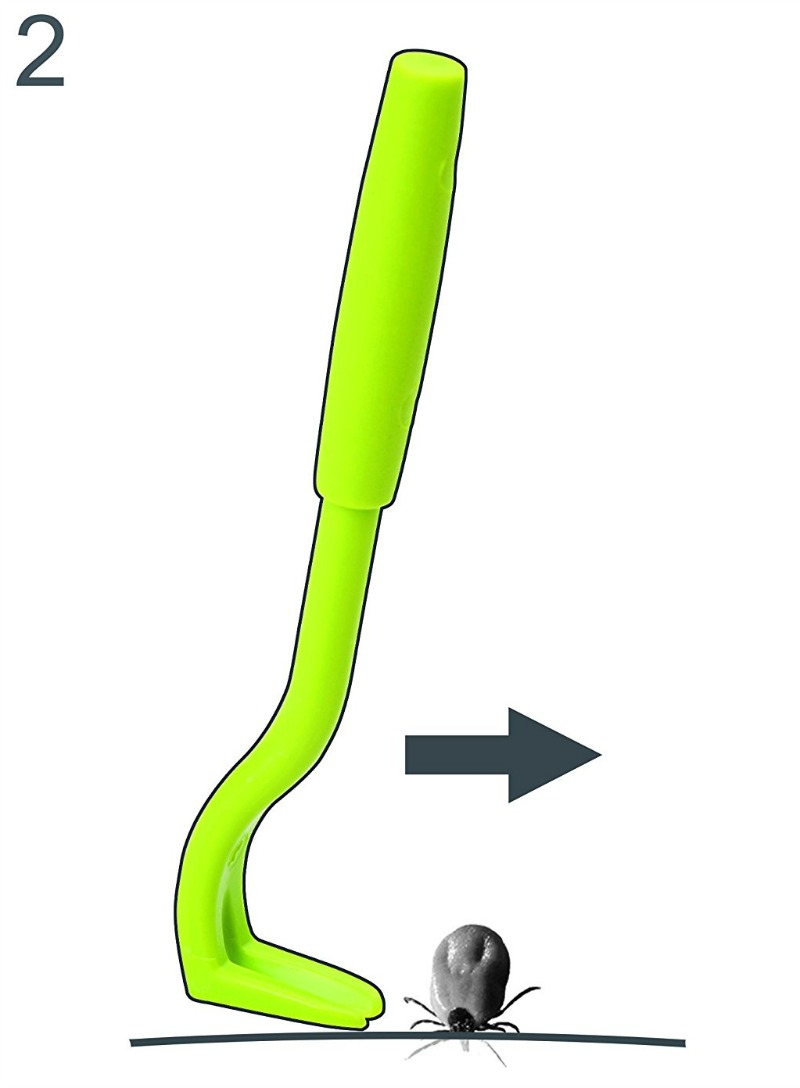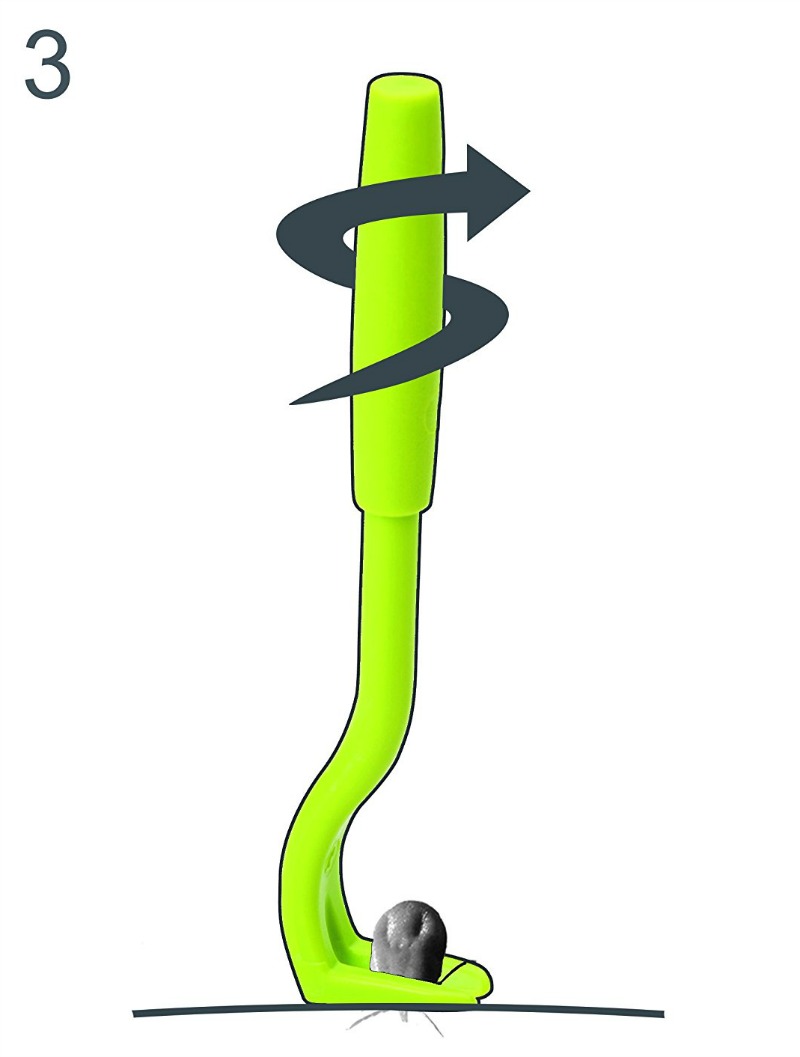Safe method to remove a tick without leaving the head stuck in the skin that works with small or large ticks and is easier than tweezers.

Each spring and summer, warmer weather and spending more time outside and camping outdoors increases the chances of exposure to nasty tick bites. The question is not “if” but “when” it will happen. And, when it inevitably does, how to remove a tick safely to minimize the chances of disease?
I have a friend who lives on a farm in Kentucky with his wife and five children. During tick season, he and his wife perform tick checks every night on all their children right before bathtime. They take ticks very seriously in their home because the Lyme disease carrying kind are very prevalent in their area.
It’s not just Lyme disease that is a potential risk either. The Journal of General Internal Medicine published an article by Susan Wolver, MD, and Diane Sun, MD, which identified a rising trend of red meat allergies from tick bites.
When one of my children was a fairly young baby and not even mobile yet, a tick lodged itself into the top of his head. Most likely, the tick dropped out of a tree onto his head, so don’t think your children are safe just because they aren’t hiking in the woods or walking in the grass!
If you discover that your child or pet has a tick that has lodged itself into the skin, here is the safest, easiest and quickest way to remove it.
How to Remove a Tick Safely and Quickly
The best way to remove ticks is using tweezers according to most authoritative sources. However, there is a new gadget called the tick twister remover that works even better.
My friend in Kentucky says that they used to use tweezers, but the tick twister is far superior and easier to use. It can be used to remove ticks from both pets and people.
Each tick twister tick removal set (it only costs about $6) has two removers inside: one large and one small. The different size is to allow for safe removal of both small and large ticks.
This ingenious device created by a veterinarian to safely remove ticks regardless of a person’s expertise has the following benefits:
- It is easier to use than tweezers especially for small ticks.
- It removes the tick without squeezing it, which greatly reduces the chances of disease transmission.
- It ensures the head and mouthparts of the tick are removed along with the body.
- It can be used for both large and small ticks.
Every home with children and/or pets should have one of these! It should also be included with camping equipment.
Safe Removal Steps. Better than Tweezers!
There are three steps for removing a tick using the tick twister.
First, you select which tick twister to use. If the tick is large, use the larger tick twister. If the tick is small, use the smaller one. Pretty simple!

Second, you grasp the tick between the head and body using the hook end of the tick twister. The picture below shows how to do it.

Third, simply twist the tick twister gently to easily and safely remove the entire tick out of the skin. That’s it!

After removing the tick, thoroughly clean the affected skin with alcohol. If there is any irritation, a dab of this herbal salve does wonders to quickly heal the skin.
Warning About some Tick Removal Recommendations
Some sources recommend pulling a tick straight out of the skin as the best method of removal.
This is very dangerous advice, because trying to pull a tick straight out will almost ALWAYS result in the head staying stuck in the skin. This is because ticks frequently lodge into the skin at an angle. They don’t usually burrow straight in perpendicular to the skin’s surface.
If you must use tweezers because you don’t have the tick twister remover available, be sure to pull the tick out at the same angle it went in.
This will give you the best shot at removing the head along with the body. In other words, grab the tick very firmly and close to the head as you can and pull out on a straight line but the same angle it burrowed in. I hope this makes sense.
It’s a little difficult to describe in words. This is the method taught to me by my Dad, who is a retired family doctor. Using this method, I’ve never left a tick’s head in the skin of any pet or person in over 40 years.
Of course, using the inexpensive tick twister is the best method of all. You don’t have to worry about angles – you simply twist the tick out of the skin!
How to Repel Ticks
This article describes the method for preparing an herbal yarrow tincture which is very effective at repelling ticks so you don’t have to remove them in the first place.
You ideally need to spray yourself every 2 hours or so.
Note that yarrow has been reputedly found by the US Army to be as effective as DEET in repelling ticks.








Report on a study comparing tick removal tools, including an explanation of how a tick attaches and why we remove it the way we do. Good, simple directions for removal.
Judith, I have been reading all the comments. Living near a sheep ranch when young, shearing time was a time for everyone to inspect. What do you do when a tick embeds itself under the skin…no way to take it out with tweezers or even reach the head. It has to back out! I am sure I remember seeing an embedded tick and it looked like a reddish round lump…
Carol, what country are you in? I don’t believe there are any ticks in North America that actually burrow under the skin, and I’ve never heard of a tick elsewhere doing this either. Ticks insert their mouthparts into the skin, and the rest of the tick stays above the skin. I’ve been pulling ticks since I was a little kid (off of our dog back then) for more than 50 years, all the tick species in the eastern US and probably a few others, and I have always used fine-pointed tweezers. I have never seen a tick where I couldn’t get a grasp down at the head and get it off. The body of the tick has always been outside the skin. If a tick was under the skin, it couldn’t back out! So I wonder what it was you were seeing. Did you try to remove those ticks? I wonder if you were seeing a fully engorged tick (their color is lighter than a tick that hasn’t fed, and they do look reddish sometimes, and round and lumpy). If you didn’t try removing the tick, I would bet that you would have discovered it was attached only at the mouthparts. Or it was not a tick, but something else. Was this on a human? (“Embedded” is not an accurate word to use, since the only thing inserted is the mouthparts. I prefer “attached.”)
Yes, ticks can become ’embedded’:
https://www.google.com/search?q=embedded+tick&ie=utf-8&oe=utf-8&aq=t&rls=org.mozilla:en-US:official
The tick doesn’t burrow, though. It attaches with mouthparts only. But the skin will swell around it and can swell enough to hide the tick pretty well. Usually there’s a bit of tick hanging out, but it can appear almost as an abscess with the tick in a depressed area at the center. Like this one:
That is a misuse of the word “embedded.” Look it up. The tick is not embedded. Its mouthparts are embedded superficially in the skin. Those images show a tick above the skin that would be easy to grasp with fine-pointed tweezers and easy to pull off. It is not firmly fixed in the tissue.
NCSU has one of the top tick labs on the country. Here is a link to some of their tick info:
They have directions for tick removal and avoiding ticks there.
I ask that this article be removed. It is making the rounds on facebook and twitter and spreading dangerous misinformation!!!
This kind of approach has been debunked. When you suffocate the tick in this way, the stress causes the tick to regurgitate its stomach contents into the bloodstream–including all the bacteria and parasites that the tick carries. A tweezers is the best method. The ones that are spread out triangularly and join together in a thin line are best I think, as they get beneath the body of the tick close to the skin. Then you “as gently as possible” and slowly twist it out. You want to avoid shocking the tick.
In the old days hunters would burn them off with their cigarettes.
Oy. Please don’t do this. Doing anything to the tick besides just pulling it off will put you in serious danger of catching a tick borne disease. I’ve been a member of the tick list for dogs for a decade. The group includes entomologists and vets who are top tick experts. My information is from that list. And if you go to any good public health site, you will find the same information I am going to write here. Don’t fool around with a tick! Just use appropriate tools (including tweezers) and pull that sucker off, grasping as close to the head as possible, and pulling steadily away from the skin.
If you irritate the tick by applying anything to it, or handling it much, in order to “suffocate” it (which won’t happen) or to make it detach itself, you will cause it to regurgitate some of its gut contents into the bite wound in the process of detaching. This information is straight from a person who studies ticks. You don’t want that to happen, because it increases the chance that the tick will transmit disease. For several hours after it attaches, any pathogens the tick carries are still down in the gut, and are not transmitted. After it feeds for several hours (no one knows exactly how long this takes, possibly 12 hours or so, possibly sooner), the pathogens move up into the mouthparts and are transmitted into the bite wound.
If you are removing a tick before the pathogens have moved up from the gut, you really don’t want gut contents puked into the bite wound, because it greatly increases the chance the tick will transmit disease. Any knowledgeable health practitioner will tell you not to irritate the tick. Tweezers are recommended, if they are fine-pointed. You want to grasp down at the head, and avoid squeezing the tick’s body, because you may release infective body fluids. You want to remove the tick with its body intact, rather than broken open. The mouthparts are less of an issue.
The mouthparts are actually not a significant problem if they remain attached. They will act like a splinter, but are no longer able to transmit tick-borne disease once the tick is removed. Treat them as a small splinter; you can dig them out if you want to (I never have), but they can only cause local inflammation or a minor local skin infection. They will not transmit Lyme disease, Ehrlichiosis, RMSF, or other TBDs. Don’t sweat the mouthparts!
If you grasp with a fine-pointed tweezers down at the head, and pull steadily and slowly, you are probably going to remove the whole tick,, including mouthparts. Don’t jerk the tick off. I have removed literally thousands of ticks from myself and dogs over many years, and it’s extremely rare that the mouthparts stay attached. I think it has been years since I observed that happen. I also don’t pay attention to the angle with which I pull, but I do pull very smoothly and rather slowly.
Please, please don’t do anything else. Delaying tick removal is in itself dangerous, as the longer they are attached, the more likely they will transmit disease.
This suggestion from the nurse has been circulating the internet for years. It is dangerous. Please retract the suggestion, look at a few actual public health sites from states where ticks are common, and don’t share it further.
Here is an excellent list of tick sites:
saluqi.home.netcom.com/ticklinks.htm
For some reason, it’s not accessible now but it will be fixed soon, I’m sure. Most of the links listed there are for dogs, but there are some general links from expert sources. I would not go to Snopes for health information. Go to the health experts.
If you don’t want to use a tweezers, try the Tick Scoop or the Tick Key. I just got a tick key and it works very well, but I still use fine-pointed tweezers for most tick removal, especially in tight spots. Some people use hemostats and similar tools. But please don’t fool around with a tick. Just pull that sucker off!
Thank you so much for this information, Judith! We have also always used the traditional tweezers method and have read over and over that it is the best method, however I did not know about the regurgitation, etc! Another tip I would add is to put Oil of Oregano on the site to help kill any possible infection. I recently had a friend whose son almost died from Rocky Mountain Spotted Fever from a tick. Before this, living in the woods, we did not worry so much about them and neither did they. Now we are more careful about doing tick checks and using essential oils as a bug spray. Ticks sense the warmth of a human approaching and then drop themselves from trees onto you. Heebie-jeebies. They are evil, lol.
Nickole
I’ve never heard they drop from trees, though I suppose it’s possible. I’ve always believed they were in leaf litter, tall grasses and areas that are overgrown with shrubs and other low-lying plants. They’re also frequently on pets and then get transmitted to humans.
I 100% agree that ticks should be removed with tweezers as close to the skin as possible ASAP! Better to risk a retained tick head than to allow a tick to stay on the animal/person, and increase the chances of transmission of Lyme Disease or other tick-borne infections. Experts do not agree upon much when it comes to Lyme Disease, EXCEPT that ticks should be removed as soon as possible via the tweezer method.
I am from Vermont, where Lyme infected ticks run rampant. I know several people whose lives have been FOREVER changed by Lyme encephalitis, Lyme arthritis, and Lyme coinfections. For many, Lyme and its coinfections are the proverbial gifts that keep on giving, only they are gifts that you ABSOLUTELY DO NOT WANT.
USE TWEEZERS to remove the tick as close to the skin as possible and as quickly as possible, and decrease your chances of being harmed by MANY devastating tick-borne diseases!
Thank you! Any advice to repel fleas from the yard, house and animals without the chemicals?
Beneficial nematodes can be used in the yard to control ticks, fleas and a host of pests, depending on your soil type and climate. Nem’s have to be kept moist, so won’t work well in desert, and you need to be willing to water the yard in a drought. Arbico.com is one source and there is info on their site. (There are other sources but I’ve had good reports about Arbico’s nematodes.) They may not list tick control in the nematode section on their website, but you can call them and get info on which type nematode to use for your yard and soil type. I have heard from several people that they work well for ticks and fleas. They die off in a hard frost, so have to be reapplied every year in most areas. They don’t harm beneficial organisms, pets, people, etc but they reduce many pests. I may try them this year, but I am in the woods and I think I have to clear out all underbrush, leaves, etc. first. That would help reduce the tick population also. Arbico usually has a sale on nematodes late in the season.
We have always used these on the dogs and ourselves and they work very well.
Can I ask please, my son had a tick in his botto
(the cheek part) and I suffocated it with coconut oil and it came out. It’s been about 6 months and he still has a red itchy spot on his bum,a little raised, not inflamed but a little red coloured. What should I do with it? I don’t know whether something is still in there, it doesn’t look like it,but I don’t know. It doesn’t bother him, he just scratches it a bit when I take his nappy off in the morning…?
Lissi,
Please send your son to a doctor immediately. I do not want to seem like an alarmist, but Lyme disease is no easy cure unless you catch it right away. Take photos of the rash. Save for a lifetime. Date the photos. Idoctors are highly uneducated about Akyme disease. I live in California, there are only a handful of doctors in the state that know how to treat it.
If that is a Lyme rash (kind of like a bullseye) I would not try to self treat. I was against antibiotics until I was sickened for the past 3 years with the disease. Nearly took my life. It has been a long road to regaining partial health.
20/20 had a segment on last night with a girl with Lyme. Dr. Phil just had a segment last month.
Fastest growing infectious disease in the US. Faster than AIDS.
LymeDisease.org can help you find a doctor. Do not accept “no” as an answer. Find another doctor.
Listen to her! My daughter had a tick several years ago. We live in KY. We saved the tick and she got a bullseye on her scalp. The doctor told us it was the ‘wrong kind of tick’ and that ‘since we hadn’t been to the New England area, there was no way it was Lyme’ but I knew better!! Our doctor was arrogant and rude. He didn’t even look at her head–just the tick! You can get Lyme from anything that is carrying it–any kind of tick, mosquito…anything that bites. From the research I did, if you have a bullseye, that IS LYME. But it can still by Lyme without the bullseye.
I finally took her to my naturopath who put her on her biofeedback machine, which diagnosed her immediately with Lyme. They treated her on the biofeedback machine and with chinese herbs until the Lyme no longer showed up. It took weeks, but she hasn’t had a symptom since. You really, really need to find a Lyme-literate doctor–someone who knows what they are talking about–which aren’t very easily found unless you are in the New England area. Lyme is a very serious disease and should be treated NOW. Don’t wait to find out. Years down the road there can be neurological damage. Good luck and God bless!
Thankyou I will sort this out now.